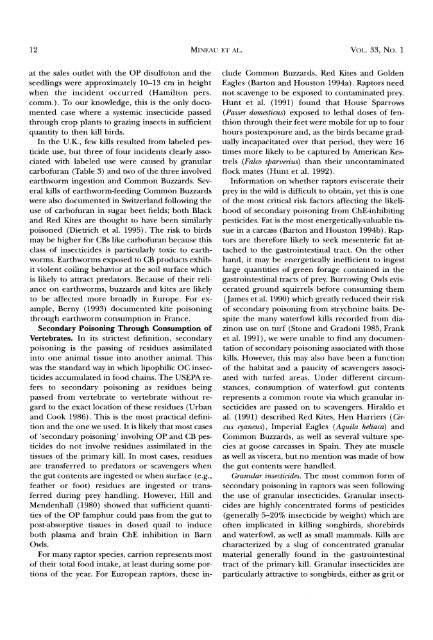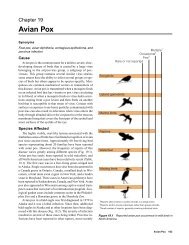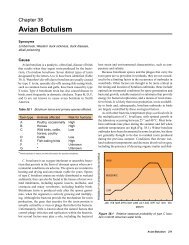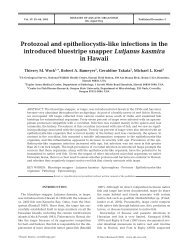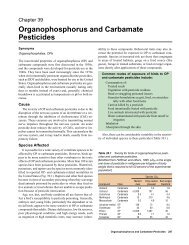poisoning of raptors with organophosphorus and carbamate ...
poisoning of raptors with organophosphorus and carbamate ...
poisoning of raptors with organophosphorus and carbamate ...
Create successful ePaper yourself
Turn your PDF publications into a flip-book with our unique Google optimized e-Paper software.
12 MtNE^t: Ea: A•. VOI•. 33, NO. 1<br />
at the sales outlet <strong>with</strong> the OP disulfoton <strong>and</strong> the<br />
seedlings were approximately 10-13 cm in height<br />
when the incident occurred (Hamilton pers.<br />
comm.). To our knowledge, this is the only documented<br />
case where a systemic insecticide passed<br />
through crop plants to grazing insects in sufficient<br />
quantity to then kill birds.<br />
In the U.K., few kills resulted from labeled pesticide<br />
use, but three <strong>of</strong> four incidents clearly associated<br />
<strong>with</strong> labeled use were caused by granular<br />
carb<strong>of</strong>uran (Table 3) <strong>and</strong> two <strong>of</strong> the three involved<br />
earthworm ingestion <strong>and</strong> Common Buzzards. Several<br />
kills <strong>of</strong> earthworm-feeding Common Buzzards<br />
were also documented in Switzerl<strong>and</strong> following the<br />
use <strong>of</strong> carb<strong>of</strong>uran in sugar beet fields; both Black<br />
<strong>and</strong> Red Kites are thought to have been similarly<br />
poisoned (Dietrich et al. 1995). The risk to birds<br />
may be higher for CBs like carb<strong>of</strong>uran because this<br />
class <strong>of</strong> insecticides is particularly toxic to earthworms.<br />
Earthworms exposed to CB products exhibit<br />
violent coiling behavior at the soil surface which<br />
is likely to attract predators. Because <strong>of</strong> their reliance<br />
on earthworms, buzzards <strong>and</strong> kites are likely<br />
to be affected more broadly in Europe. For example,<br />
Berny (1993) documented kite <strong>poisoning</strong><br />
through earthworm consumption in France.<br />
Secondary Poisoning Through Consumption <strong>of</strong><br />
Vertebrates. In its strictest definition, secondary<br />
<strong>poisoning</strong> is the passing <strong>of</strong> residues assimilated<br />
into one animal tissue into another animal. This<br />
was the st<strong>and</strong>ard way in which lipophilic OC insecticides<br />
accumulated in food chains. The USEPA re-<br />
fers to secondary <strong>poisoning</strong> as residues being<br />
passed from vertebrate to vertebrate <strong>with</strong>out regard<br />
to the exact location <strong>of</strong> these residues (Urban<br />
<strong>and</strong> Cook 1986). This is the most practical definition<br />
<strong>and</strong> the one we used. It is likely that most cases<br />
<strong>of</strong> 'secondary <strong>poisoning</strong>' involving OP <strong>and</strong> CB pesticides<br />
do not involve residues assimilated in the<br />
tissues <strong>of</strong> the primary kill. In most cases, residues<br />
are transferred to predators or scavengers when<br />
the gut contents are ingested or when surface (e.g.,<br />
feather or foot) residues are ingested or transferred<br />
during prey h<strong>and</strong>ling. However, Hill <strong>and</strong><br />
Mendenhall (1980) showed that sufficient quantities<br />
<strong>of</strong> the OP famphur could pass from the gut to<br />
post-absorptive tissues in dosed quail to induce<br />
both plasma <strong>and</strong> brain ChE inhibition in Barn<br />
Owls.<br />
For many raptor species, carrion represents most<br />
<strong>of</strong> their total food intake, at least during some portions<br />
<strong>of</strong> the year. For European <strong>raptors</strong>, these in-<br />
clude Common Buzzards, Red Kites <strong>and</strong> Golden<br />
Eagles (Barton <strong>and</strong> Houston 1994a). Raptors need<br />
not scavenge to be exposed to contaminated prey.<br />
Hunt et al. (1991) found that House Sparrows<br />
(Passer domesticus) exposed to lethal doses <strong>of</strong> fenthion<br />
through their feet were mobile for up to four<br />
hours postexposure <strong>and</strong>, as the birds became gradually<br />
incapacitated over that period, they were 16<br />
times more likely to be captured by American Kestrels<br />
(Falco sparverius) than their uncontaminated<br />
flock mates (Hunt et al. 1992).<br />
Information on whether <strong>raptors</strong> eviscerate their<br />
prey in the wild is difficult to obtain, yet this is one<br />
<strong>of</strong> the most critical risk factors affecting the likelihood<br />
<strong>of</strong> secondary <strong>poisoning</strong> from ChE-inhibiting<br />
pesticides. Fat is the most energetically-valuable tissue<br />
in a carcass (Barton <strong>and</strong> Houston 1994b). Raptors<br />
are therefore likely to seek mesenteric fat attached<br />
to the gastrointestinal tract. On the other<br />
h<strong>and</strong>, it may be energetically inefficient to ingest<br />
large quantities <strong>of</strong> green forage contained in the<br />
gastrointestinal tracts <strong>of</strong> prey. Burrowing Owls eviscerated<br />
ground squirrels before consuming them<br />
(James et al. 1990) which greatly reduced their risk<br />
<strong>of</strong> secondary <strong>poisoning</strong> from strychnine baits. Despite<br />
the many waterfowl kills recorded from diazinon<br />
use on turf (Stone <strong>and</strong> Gradoni 1985, Frank<br />
et al. 1991), we were unable to find any documen-<br />
tation <strong>of</strong> secondary <strong>poisoning</strong> associated <strong>with</strong> those<br />
kills. However, this may also have been a function<br />
<strong>of</strong> the habitat <strong>and</strong> a paucity <strong>of</strong> scavengers associ-<br />
ated <strong>with</strong> turfed areas. Under different circum-<br />
stances, consumption <strong>of</strong> waterfowl gut contents<br />
represents a common route via which granular insecticides<br />
are passed on to scavengers. Hiraldo et<br />
al. (1991) described Red Kites, Hen Harriers (Circus<br />
cyaneus), Imperial Eagles (Aquila heliaca) <strong>and</strong><br />
Common Buzzards, as well as several vulture species<br />
at goose carcasses in Spain. They ate muscle<br />
as well as viscera, but no mention was made <strong>of</strong> how<br />
the gut contents were h<strong>and</strong>led.<br />
Granular insecticides. The most common form <strong>of</strong><br />
secondary <strong>poisoning</strong> in <strong>raptors</strong> was seen following<br />
the use <strong>of</strong> granular insecticides. Granular insecticides<br />
are highly concentrated forms <strong>of</strong> pesticides<br />
(generally 5-20% insecticide by weight) which are<br />
<strong>of</strong>ten implicated in killing songbirds, shorebirds<br />
<strong>and</strong> waterfowl, as well as small mammals. Kills are<br />
characterized by a slug <strong>of</strong> concentrated granular<br />
material generally found in the gastrointestinal<br />
tract <strong>of</strong> the primary kill. Granular insecticides are<br />
particularly attractive to songbirds, either as grit or


